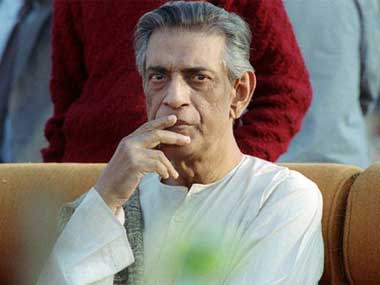When Satyajit Ray died in Kolkata in April 1992 following a prolonged illness — days after being conferred an honorary Oscar by his favourite actor Audrey Hepburn — The Telegraph newspaper carried an editorial titled “The Tall Man.” Indeed, Ray was perhaps the tallest member of Bengal’s arts and literary firmament after Tagore, someone whose cinema, books and thinking have permeated into the existence of the average Bengali and intelligentsia alike. But perhaps what makes Ray much, much more than just a great film-maker is his humanism and his relevance even today, years after his epic Pather Panchali (Song of the Little Road) first hit the screens in 1955 and changed the way Indian cinema would be perceived forever. Today, 56 years after audiences across the world were left spellbound by the story of Apu and Durga, and the travails and tribulations of a poor, rural family and the celebration of their lives, Ray remains as relevant as he ever was. Like every great storyteller the world over, Ray’s stories hold a universal appeal to this day, cutting across language and geographical barriers, tugging at heart strings across age groups and continents. Whether it is the story of forbidden love between a wealthy housewife yearning for attention and her younger brother-in-law in the adaptation of Tagore’s Nasthaneer in the classic Charulata (The Lonely Wife), or the pangs of a once powerful zamindar who has lost everything and yet clings on to his past in Jalsaghar (The Music Room), Ray’s stories always had people at their centre. People who one could relate to through the emotions they underwent, the love they felt, the jealousies they fell victim to, the weaknesses they tried to overcome. And in all these stories, the human spirit was uppermost. Whether it is the journey of Apu through the years from a little boy burdened by the responsibilities of the whole family, to an adolescent, through to his life as a married man, Satyajit Ray gave to Bibhutibhushan Bandyopadhyaya’s classical tale visual images which would remain etched in one’s mind forever. The unforgettable train sequence in Pather Panchali or the death of Durga, Apu’s sister, are now part of cinematic folklore because they spoke of raw emotions which everyone could touch and feel. [caption id=“attachment_60405” align=“alignleft” width=“380” caption=“What makes Satyajit Ray much, much more than just a great film-maker is his humanism and his relevance even today. Dominique Faget/AFP”]  [/caption] To be sure, not all of Ray’s films were only about the joys and celebration of life. There were angry films, stories that spoke of the decline of values, unemployment and the tribulations of youth. The “city trilogy” – Jana Aranya (The Middleman), Pratidwandi (The Adversary) and Seemabaddha (Company Limited) – came at a time when Bengal and, indeed India, was going through a period of socio-economic turmoil. So while Jana Aranya spoke of how a young man loses his innocence and values in the cruel materialistic world, Pratidwandi told the story of the anger and anguish of youth rebelling against the system. Seemabaddha, on the other hand, cut open the dark underbelly of corporate life in a manner which is, to this day, unparalleled in Indian cinema and gave India its first ‘corporate’ movie. The range and relevance of Satyajit Ray extended to his scripts and dialogues, and phrases from his fantasy films Goopy Gyne Bagha Byne (The story of Goopy and Bagha) and Hirak Rajar Deshe (The Kingdom of Diamonds) are today an integral part of the Bengali lexicon. The first, based on a story by Ray’s grandfather Upendrakishore Raychoudhury is, till date, one of the most definitive anti-war films ever, while the second, its sequel, tells a story of good over evil and has a script written by Ray with large parts of it in brilliant rhyme. Equally, Ray’s films on the adventures of Feluda, the fictional detective created by him, gave Bengal its very own version of Sherlock Holmes and Hercule Poirot. The latter part of Ray’s career was marked by another set of films which depicted his disappointment with the modern world. While Shakha Proshakha (Branches of a Tree) told the story of an honest patriarch watching helplessly as his family treads on the very values he holds dear, Ganashatru (An Enemy of the People), based on Ibsen’s classic, highlighted the issue of religion as a tool for the powerful. His last film, _Agantuk (_The Stranger) was a vivid example of Ray’s utter disappointment and anguish over how development and progress had completely ignored large sections of society. As new generations watch the flickering images created by Satyajit Ray on their HD television sets, Ray’s stories will still remain relevant. Because emotions, values and feelings are universal and transcend generations. Like Tagore before him, Ray will always appeal to those whose sensitivities allow them to probe deeper into society and into the human mind. The images created by him will turn yellow with time, and will need to be restored. But the emotions they convey will always remain fresh and real. That, perhaps, is the key difference between Satyajit Ray and any ordinary storyteller.
Satyajit Ray died almost 20 years ago, but even today his films have lost none of their spark or ability to touch human emotion. In a sense, his films can speak across generations and cultures.
Advertisement
End of Article
Written by Sourav Majumdar
Sourav Majumdar has been a financial journalist for over 18 years. He has worked with leading business newspapers and covered the corporate sector and financial markets. He is based in Mumbai. see more


)
)
)
)
)
)
)
)
)



